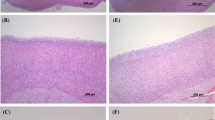Abstract
Rats were subjected to 4 h continuous or intermittent exposure to vinyl chloride (VC) at different time-weighted average concentrations (15, 50, 150, 500 and 15,000 mg/m3). Hepatic non-protein sulfhydryl content (NPSH) and excretion of thiodiglycolic acid (TdGA) in urine were determined. VC at concentrations from 50 mg/m3 to 15,000 mg/m3 caused a dose-dependent depression of NPSH, but no difference in the magnitude of this depression induced by continuous or intermittent exposure at the same average concentration of VC was noted. At average concentrations of 50 mg/m3 and 150 mg/m3, the urinary excretion of TdGA under continuous exposure did not differ from that under intermittent exposure, whereas at VC concentrations of 500 mg/m3 and 15,000 mg/m3 it was higher following continuous exposure.
Similar content being viewed by others
References
Barbin A, Bresil H, Croisy A, Jacquignon P, Montesano R, Bartsch H (1975) Liver microsome-mediated formation of alkylating agents from vinyl bromide and vinyl chloride. Biochem Biophys Res Commun 67:596–603
Bartsch H, Malaveille C, Barbin A, Planche G (1979) Mutagenic and alkylating metabolites of halo-ethylenes, chlorobutadienes, and dichlorobutadienes produced by rodent or human liver tissue: evidence for oxirane formation by P450-linked microsomal mono-oxygenases. Arch Toxicol 41:249–277
Bolt HM, Filser JG, Buchter A (1981) Inhalation pharmacokinetics based on gas uptake studies. III A pharmacokinetic assessment in man of “peak concentrations” of vinyl chloride. Arch Toxicol 48:213–228
Dramiński W, Trojanowska B (1981) Chromatographic determination of thiodiglycolic acid — a metabolite of vinyl chloride. Arch Toxicol 48:289–292
Ellman GL (1959) Tissue sulfhydryl groups. Arch Biochem Biophys 82:70–77
Filser JG, Bolt HM (1979) Pharmacokinetics of halogenated ethylenes in rats. Arch Toxicol 42:123–136
Gehring PJ, Watanabe PG, Park CN (1978) Resolution of dose-response toxicity data for chemicals requiring metabolic activation: Example — vinyl chloride. Toxicol Appl Pharmacol 44:581–591
Green T, Hathway DE (1975) The biological fate in rats of vinyl chloride in relation to its oncogenicity. Chem Biol Interact 11:545–562
Green T, Hathway DE (1977) The chemistry and biogenesis of the S-containing metabolites of vinyl chloride in rats. Chem Biol Interact 17:137–150
Guengerich FP, Crawford WM, Watanabe PG (1979) Activation of vinyl chloride to covalently bound metabolites: roles of 2-chloroethylene oxide and 2-chloroacetaldehyde. Biochemistry 18:5177–5182
Guengerich FP, Mason PS, Stott WT, Fox TR, Watanabe PG (1981) Roles of 2-haloethylene oxides and 2-haloacetaldehydes derived from vinyl bromide and vinyl chloride in inreversible binding to protein and DNA. Cancer Res 41:4391–4398
Hefner RE, Watanabe PG, Gehring PJ (1975) Preliminary studies of the fate of inhaled vinyl chloride monomer in rats. Ann N Y Acad Sci 246:135–148
Krajewski J, Dobecki M (1978) Determination of vinyl chloride in the air by gas chromatographic method (in Polish). Med Pracy 29:403–410
Malaveille C, Bartsch H, Barbin A, Camus AM, Montesano R (1975) Mutagenicity of vinyl chloride, chloroethyleneoxide, chloroacetaldehyde and chloroethanol. Biochem Biophys Res Commun 63:363–370
McCann J, Simmon V, Streitwieser D, Ames BH (1975) Mutagenicity of chloroacetaldehyde, a possible metabolic product of 1,2-dichloroethane (ethylene dichloride), chloroethanol (ethylene chlorohydrine), vinyl chloride, and cyclophosphamide. Proc Natl Acad Sci USA 72:3190–3193
Müller G, Norpoth K (1975) Bestimmung zweier Urinmetabolite des Vinylchlorids. Naturwissenschaften 62:541
Müller G, Norpoth K, Eckard R (1976) Identification of two urine metabolites of vinyl chloride by GC-MS-investigations. Int Arch Occup Environ Health 38:69–75
Müller G, Norpoth K, Kusters E, Herweg K, Versin E (1978) Determination of thiodiglycolic acid in urine specimens of vinyl chloride exposed workers. Int Arch Occup Environ Health 41:199–205
Müller G, Norpoth K, Wickramasinghe RH (1979) An analitical method, using GC-MS, for the quantitative determination of urinary thiodiglycolic acid. Int Arch Occup Environ Health 44:185–191
Tarkowski S, Wiśniewska-Knypl JM, Klimczak J, Dramiński W, Wróblewska K (1980) Urinary excretion of thiodiglycolic acid and hepatic content of free thiols in rats at different levels of exposure to vinyl chloride. J Hyg Epidemiol Microbiol Immunol 24:253–261
Watanabe PG, Hefner RE, Gehring PJ (1976a) Vinyl chloride induced depression of hepatic non-protein sulfhydryl content and effects on bromosulphalein (BPS) clearence in rats. Toxicology 6:1–8
Watanabe PG, McGowan GR, Gehring PJ (1976b) Fate of (14C) vinyl chloride after single oral administration in rats. Toxicol Appl Pharmacol 36:339–352
Watanabe PG, McGowan GR, Madrid EO, Gehring PJ (1976c) Fate of (14C) vinyl chloride following inhalation exposure in rats. Toxicol Appl Pharmacol 37:49–59
Watanabe PG, Zempel JA, Gehring PJ (1978a) Comparison of the fate of vinyl chloride following single and repeated exposure in rats. Toxicol Appl Pharmacol 44:391–399
Watanabe PG, Zempel JA, Pegg DG, Gehring PJ (1978b) Hepatic macromolecular binding following exposure to vinyl chloride. Toxicol Appl Pharmacol 44:571–579
Wiśniewska-Knypl JM, Sokal JA, Klimczak J, Dajniak A, Bogdanikowa B (1981) Protective effect of methionine against vinyl chloride-mediated depression of non-protein sulfhydryls and cytochrome P-450. Toxicol Lett 8:147–152
Zajdela F, Croisy A, Barbin A, Malaveille C, Tomatis L, Bartsch H (1980) Carcinogenicity of chloroethylene oxide, an ultimate reactive metabolite of vinyl chloride, and bis (chloromethyl) ether after subcutaneous administration and in initiation-promotion experiments in mice. Cancer Res 40:352–356
Author information
Authors and Affiliations
Rights and permissions
About this article
Cite this article
Jedrychowski, R.A., Sokal, J.A. & Chmielnicka, J. Influence of exposure mode on vinyl chloride action. Arch Toxicol 55, 195–198 (1984). https://doi.org/10.1007/BF00316128
Received:
Accepted:
Issue Date:
DOI: https://doi.org/10.1007/BF00316128




